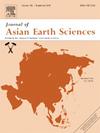Influence of décollement friction on magnetic fabrics of sedimentary rocks: Insights from AMS analysis in the Kohat fold-thrust belt, Pakistan
IF 2.7
3区 地球科学
Q2 GEOSCIENCES, MULTIDISCIPLINARY
引用次数: 0
Abstract
The Kohat fold-thrust belt (KFTB) in the northwestern Himalayan foreland provides a unique opportunity to investigate strain partitioning and the role of evaporitic décollement in fold-thrust belts (FTBs) propagation through magnetic fabrics analysis. Using anisotropy of magnetic susceptibility (AMS) as a strain marker through analog models of FTBs, have already demonstrated the impact of high and low friction décollement in the magnetic fabrics development. In order to validate the accuracy of such model and to enhance the understanding of strain partitioning in FTBs with low-friction décollements, an integrated framework combining AMS and structural analyses was applied to the KFTB. AMS investigations of oriented cores from the Siwalik strata of 72 sites, acquired at different structural levels within the KFTB, highlight distinct magnetic fabric patterns. The low-friction décollement-proximate Siwalik strata exhibit Type-I sedimentary magnetic fabrics, the décollement-distal strata possess intermediate fabrics and the décollement front strata exhibit Type-VI tectonic fabrics. Collectively, the AMS parameters analysis and magnetic fabrics classification reflect the influence of structural controls on magnetic fabrics development. The Type-I sedimentary magnetic fabrics in the Early Miocene Kamlial Formation signify paleo-Indus flow direction towards southeast direction in the KFTB. A new conceptual schematic model integrated with bootstrapped AMS ellipsoids along different structures of the KFTB emphasize the influence of décollement friction, intensity of deformation and FTB propagation over weak layers.
巴基斯坦Kohat褶皱冲断带磁导摩擦对沉积岩磁性组构的影响
通过磁组织分析,研究喜马拉雅西北前陆科哈特褶皱冲断带(KFTB)的应变分配和蒸发模拟在褶皱冲断带(FTBs)传播中的作用提供了一个独特的机会。利用磁导率各向异性(AMS)作为应变标志,通过对光纤织物的模拟模型,已经证明了高摩擦和低摩擦对磁性织物发展的影响。为了验证该模型的准确性,并加强对低摩擦dims - dims - KFTB应变分配的理解,将AMS和结构分析相结合的集成框架应用于KFTB。在KFTB的不同结构水平上,对Siwalik地层72个地点的定向岩心进行了AMS调查,突出了不同的磁性结构模式。低摩擦Siwalik地层表现为i型沉积磁组构,远端地层表现为中间构造,前缘地层表现为vi型构造。综上所述,AMS参数分析和磁性织物分类反映了结构控制对磁性织物发展的影响。早中新世Kamlial组ⅰ型沉积磁组构标志着古印度河流向东南方向。一个新的概念原理模型集成了沿不同KFTB结构的自启动AMS椭球体,强调了在弱层上的变形强度和FTB传播的影响。
本文章由计算机程序翻译,如有差异,请以英文原文为准。
求助全文
约1分钟内获得全文
求助全文
来源期刊

Journal of Asian Earth Sciences
地学-地球科学综合
CiteScore
5.90
自引率
10.00%
发文量
324
审稿时长
71 days
期刊介绍:
Journal of Asian Earth Sciences has an open access mirror journal Journal of Asian Earth Sciences: X, sharing the same aims and scope, editorial team, submission system and rigorous peer review.
The Journal of Asian Earth Sciences is an international interdisciplinary journal devoted to all aspects of research related to the solid Earth Sciences of Asia. The Journal publishes high quality, peer-reviewed scientific papers on the regional geology, tectonics, geochemistry and geophysics of Asia. It will be devoted primarily to research papers but short communications relating to new developments of broad interest, reviews and book reviews will also be included. Papers must have international appeal and should present work of more than local significance.
The scope includes deep processes of the Asian continent and its adjacent oceans; seismology and earthquakes; orogeny, magmatism, metamorphism and volcanism; growth, deformation and destruction of the Asian crust; crust-mantle interaction; evolution of life (early life, biostratigraphy, biogeography and mass-extinction); fluids, fluxes and reservoirs of mineral and energy resources; surface processes (weathering, erosion, transport and deposition of sediments) and resulting geomorphology; and the response of the Earth to global climate change as viewed within the Asian continent and surrounding oceans.
 求助内容:
求助内容: 应助结果提醒方式:
应助结果提醒方式:


